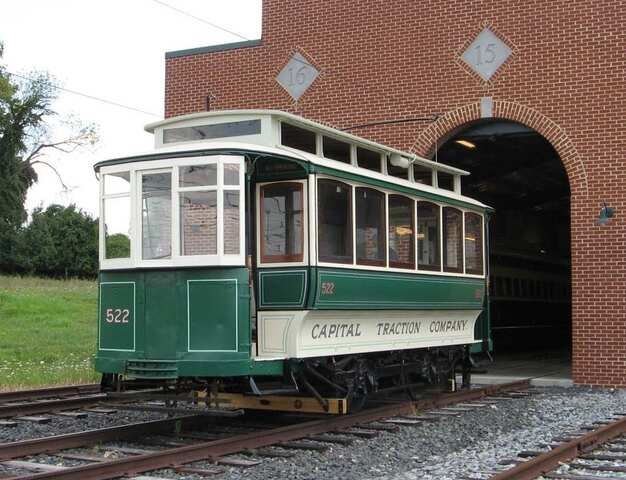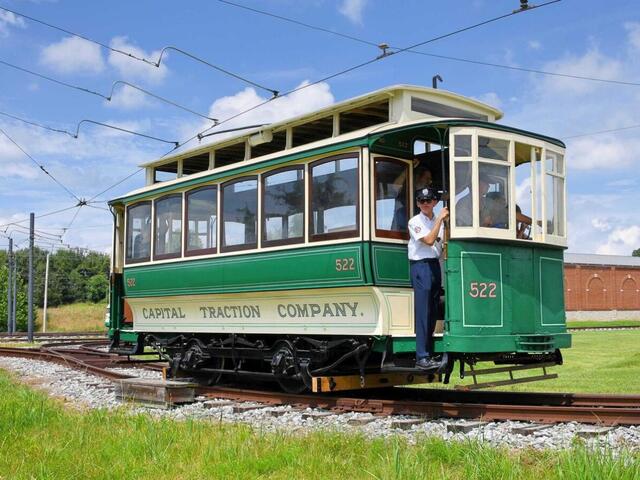Capital Traction 522
Facts and Figures
| Current Number | 522 |
|---|
| Railway Represented | Capital Traction |
|---|
| Builder | American Car Company |
|---|
| Built In | 1898 |
|---|
| Builder's order id | |
|---|
| Currently in (State) | Maryland |
|---|
| --(Locality) | Wheaton |
|---|
| Totally out of svc date | 1962 |
|---|
| (Initial retirement date) | |
|---|
| Car Type | streetcar |
|---|
| -subtype | closed |
|---|
| -designation | |
|---|
| Status | operated occasionally |
|---|
| More info | http://dctrolley.org/CTCo222.htm |
|---|
| Gauge | 4'8.5" |
|---|
| Construction | wood |
|---|
| Roof type | DR |
|---|
| Ended | DE |
|---|
| Length | 25'6" |
|---|
| Width | 7'8" |
|---|
| Height | 11'1" |
|---|
| Weight | 19990 |
|---|
| #Seats | 26 |
|---|
| #Wheels/Conf. | 4 |
|---|
| Total HP | 70 |
|---|
| Trucks | Lord Baltimore |
|---|
| Brakes | Hand |
|---|
| Compressor | n/a |
|---|
| Control | K-27A |
|---|
| Motors | GE 1000 (2) |
|---|
| Voltage (if not 600DC) | |
|---|
| Notes | Rebuilt to Capital Transit rail grinder #0522 in 1937 |
|---|
|
|
|
|
Car History by Wesley Paulson
Capital Traction 522
One of Washington's most spectacular fires occurred on September 29, 1897 when the Capital traction Company (CTCo) powerhouse burned to the ground. The loss of this plant brought the Company's cable operations to a halt. CTCo immediately converted its cable cars for horse car operation and service resumed the next day. With the loss of the cable system, the Company proceeded to electrify its routes and to order cars for this service. A month after the fire, the Company directors approved an order of seventy cars from the American Car Company of St. Louis, Missouri, which included what would become CTCo 522.
As specified in the order, American applied exterior paint schemes and assigned roster numbers based upon the routes the cars would serve. As originally constructed, the car was painted green and cream, numbered and lettered as CTCo 222 and assigned to the Pennsylvania Avenue route. The cars in this order pulled open and closed trailers which were also numbered in a similar manner. Thus CTCo motor 222 was used in service with companion trailer 222.
Two events in the early 1900s changed the appearance of CTCo 222. An order of the District of Columbia Electric Railway Commission altered the classic lines of the car by requiring enclosed platforms. CTCo installed "portable vestibules" to fulfill the requirement by January 31, 1905. In 1906, CTCo stopped lettering the exterior of its cars for specific routes and renumbered its single truck cars and trailers. CTCo 222 became CTCo 522 and continued to serve on the Pennsylvania Avenue route. In 1912, The District of Columbia Public Utilities Commission issued an order requiring a conductor on each car. As a result, CTCo withdrew all single truck passenger equipment from service on January 31, 1913. CTCo sold a large number of these surplus cars in the next few years, but retained 522 in storage. As also with sister CTCo 303, the arrival of the PCC cars in Washington in 1937 secured the future of CTCo 522, albeit for a different reason.
The sound-dampening feature of PCC wheel design corrugated the rail surface where the cars made frequent stops. To counter this problem, Capital Transit converted CTCo 522 to a rail grinder and renumbered it 0522. (All work cars were numbered with the numeral "0" as a prefix.) Replacing its Lord Baltimore truck with a modified Brill 21E allowed the body and grinding equipment to shift when it was necessary to work on curved sections of rail. Addition of a trolley pole, Golden Glow headlights, and red marker lamps enabled the car to travel system wide at night. Finally, bright orange paint replaced the traditional CTCo green and cream.
DC Transit, successor to Capital Transit, retained the car on its roster as DCTS 0522, and donated the car to NCTM in 1962. In the early 1970s, members of the Museum began a partial restoration of the car body by stripping paint and removing the rail grinder equipment. The car was rewired for service and is stored in an unfinished, but operable condition.
Ownership History
Additional Media

